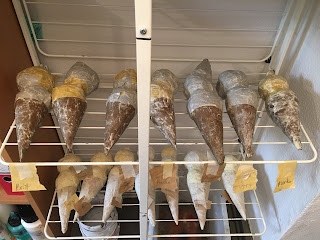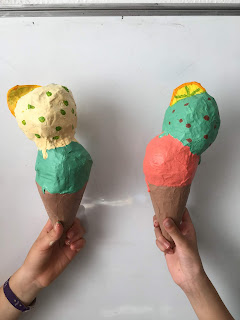We began by looking at simple illustrations of dandelions. We noted their lines, the shape of their 'dandelion puff' (the white puffy stage of the dandelion, after it's seeded), and the shape and structure of the individual seedheads, which look like downey parachutes. We discussed how, when the wind blows, these seedheads blow off the puff and dance through the wind, disseminating the attached seed elsewhere. I demonstrated on the white board how we might illustrate seedheads. Students were given many options, from a double horseshoe shape, to a simple dotted shape. One student opted for little heart shapes.
Drawing
 We began with watercolor paper, the borders of which I had pre-taped, and a pencil. I did a guided drawing demo on the board. Students had to draw three dandelions. For good composition, one should be larger than the others, and none overlapping, in the left half of their paper. We began with three simple circles, and added stems to these. We noted that dandelion stems are generally not super straight, but may have a slight curve to them. Then we sectioned our circles off into lines, the way you would cut a pizza or a pie. These initial lines are the outer seedheads. We then added extra shorter lines in between these longer lines, (slicing the pie even smaller) and made these shorter seedheads. Our goal was to draw full, fluffy dandelion puffs. Students each chose what kind of downey parachute shape they wanted at the end of their seedheadss. Most opted for a different shape for each of their three dandelions.
We began with watercolor paper, the borders of which I had pre-taped, and a pencil. I did a guided drawing demo on the board. Students had to draw three dandelions. For good composition, one should be larger than the others, and none overlapping, in the left half of their paper. We began with three simple circles, and added stems to these. We noted that dandelion stems are generally not super straight, but may have a slight curve to them. Then we sectioned our circles off into lines, the way you would cut a pizza or a pie. These initial lines are the outer seedheads. We then added extra shorter lines in between these longer lines, (slicing the pie even smaller) and made these shorter seedheads. Our goal was to draw full, fluffy dandelion puffs. Students each chose what kind of downey parachute shape they wanted at the end of their seedheadss. Most opted for a different shape for each of their three dandelions. Just like in our pen and line techniques classes earlier this year, students were encouraged to draw carefully, neatly connecting their line points, and thinking of symmetry and even spacing. Where puffs looked too 'naked' students were encouraged to add some extra seedheads for a fuller puff.
Next, we drew a few detached seedheads dancing in the wind. These should be dancing towards the right side of our paper. For good composition, their placement should be varied with some upside-down, some sideways and one trailing off towards the top right corner. This carries our eyes all the way to the other end of the paper. We noted that the parachute shape on these should match the ones on our dandelion puffs.... since they originate from these puffs. My students got this concept without a problem!
We traced all our lines with a fine permanent marker and erased our pencil lines.
For that added illustration quality, we chose to write something whimsy at the bottom of our paper. Since these students are very young, and many are English as a second or third language learners, I wrote a few options on the board for them to copy, like 'Wish', 'Make a Wish', and 'Summer'.
Rubber Cement Resist
I opted to use rubber cement on our puffs to resist the paint. Rubber cement is a rather unfriendly glue which should not be breathed in. Because I did not want my young students working with this material I decided to apply it myself to their puffs. I worked at the wide open window sill and work briskly, applying the glue to each student's puffs as they brought their work to me after finishing with their pencil erasing. We then dried these with the blow dryer and moved on to our background.
Watercolor Background
We used a wet-on-wet watercolor technique for our background. We dropped dabs of 2-3 analogous colors on our wet background, moved the paint around a bit, but not overworking it. We applied salt and dabbed with a tissue for texture. There were then dried with the blow dryer.
Lastly, we rubbed the rubber cement glue off of our dandelions using a rubber cement eraser. I recommend using an eraser specifically for removing rubber cement, as regular pencil erasers will likely simply glide over the glue, smearing and smudging what's nearby, without properly lifting the glue. The lifted glue revealed beautifully white dandelions beneath our watercolored backgrounds.
Finally, we removed the taped borders for a crisp edge. Voila! A quick, fun and summery project incorporating pen and line, illustration and watercolor techniques. A great entry into summer!
 |
| Students aged 6 and 7 |










































